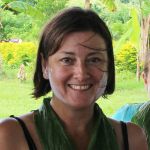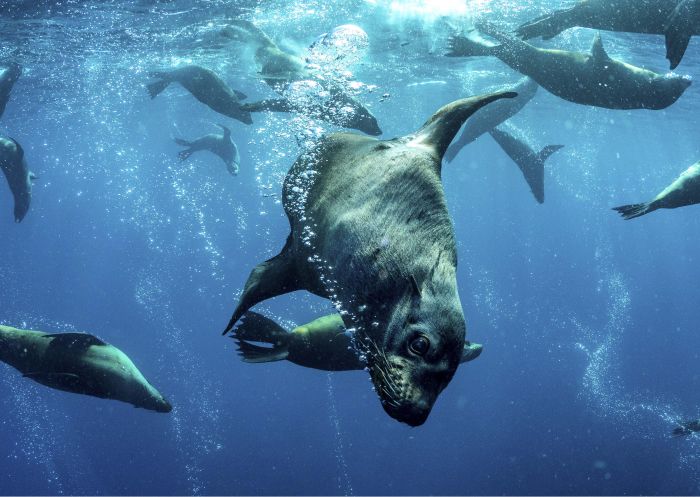

The best snorkelling spots in NSW
Man swimming with seals during a snorkelling tour with Dive Jervis Bay




Dive Expert Deborah Dickson-Smith
Cook Island is located off the coast of Fingal Head, close to the Queensland border, a small rocky island swarming with subtropical marine life. It was once known as Turtle Island, as its rocky reefs are home to a large population of sea turtles.
Located 600m offshore, the island is easily accessible in a quick run out from the Tweed River. All around the island are rocky reefs in depths from 5m to 20m, with the Northern Ledges one of the best places to see turtles. On the top of this wall are coral gardens, sea anemones full of anemonefish, abundant small reef fish and countless green turtles. Turtles gather in this area to get cleaned, and it is common to see a dozen or more lingering in the shallows.
On the sand flats beyond the reef, you may see larger creatures such as wobbegongs, blotched fantail rays and shovelnose rays. In summer, leopard sharks gather here and can be seen resting on the bottom.
Go with a guide: Watersports Guru, Cooly Eco Adventures

Cook Island, Fingal Head
Julian Rocks is a pair of small rocky outcrops located 2.5km off the main beach at Byron Bay on the North Coast of NSW.
This subtropical location is the southern-most point for many warm-water species, including loggerhead turtles, leopard sharks and manta rays, while also providing a northern holiday for cool-water critters like grey nurse sharks.
Forming a small part of the Cape Byron Marine Park, Julian Rocks has been fully protected from fishing since 2006, so the site is incredibly biodiverse. But it’s the larger creatures that snorkellers come to see, with more than 20 species of sharks and rays found here. Late summer tends to have the warmest water, best visibility and large numbers of tropical sharks and rays.
Go with a guide: Wild Byron, Out of the Blue Adventures, Blue Bay Divers

Julian Rocks, Byron Bay
Solitary Islands Marine Park is located on the NSW Mid-North Coast between Coffs Harbour and Grafton. What makes these islands so special is their proximity to the East Australian Current, which, passing close by, brings with it warm water and tropical species.
Anemone Bay is particularly famous for its enormous beds of anemones and colourful pink and purple soft corals, which cover the entire sea floor in parts. In the warmer months, snorkellers will often see leopard sharks and manta rays, and in cooler months, migrating humpback whales.
Go with a guide: Jetty Dive Centre

North Solitary Islands soft coral, Coffs Harbour - Credit: Talia Greis
Located on the NSW Mid-North Coast, the best snorkelling at Seal Rocks can be found just 100m offshore around a rocky outcrop. In the clear water surrounding this small island, you’ll see turtles, several species of sharks and rays including Port Jackson sharks, wobbegongs, fiddler rays, eagle rays, large smooth stingrays and schooling fish.
However, what makes this site really special is that it’s one of very few places you can walk right off the beach and snorkel with grey nurse sharks, with a large aggregation found here year-round.
Go with a guide: Dive Forster

Forster Dive Centre, Forster - Credit: Talia Greis
Martin Island is located off the coast of Port Kembla, roughly an hour and a half drive south of Sydney, near Wollongong. The main attraction here is the large colony of playful Australian fur seals. If you’re not too distracted by the seals, scan the shallow sea floor where, in between the seaweed and boulders, you’ll likely see large smooth stingrays, fiddler rays and Port Jackson sharks.
Go with a guide: Abyss Scuba Diving

Abyss Diving, Martin Island - Credit: Victor Hawk
Located in the Bass Point Reserve near Shellharbour on the south coast of NSW, Bushrangers Bay Aquatic Reserve is shaped like an amphitheatre, providing a sheltered habitat for various fish species. As you swim over the fields of kelp, look carefully for weedy sea dragons, very well camouflaged in the swaying weed, and under the rocky overhangs for eastern blue devils. Other marine life found here includes blue gropers, smooth stingrays and giant cuttlefish and grey nurse sharks.
Go with a guide: Shellharbour Scuba

Aquatic life in Bushrangers Bay, Shellharbour
Marine encounters at Jervis Bay, on the South Coast of NSW, will likely include Port Jackson sharks, rays, eastern blue gropers, weedy sea dragons, eastern blue devilfish and wobbegongs.
The Bay is also home to a playful colony of Australian fur seals, always a joy to snorkel with, a large pod of dolphins that usually follow the boat, and between May and September there is also the opportunity to swim with migrating humpback whales.
Go with a guide: Jervis Bay Sea Sports, Woebegone Freedive, Australia's Coastal Wilderness Adventures

Diving with seals with Dive Jervis Bay, South Coast - Credit: Jordan Robins
Off the coast of Narooma on the NSW South Coast, Montague Island is home to the largest fur seal colony on the NSW coast, with both Australian and New Zealand fur seals populating this tiny island. Take a snorkel tour here and you’ll also very likely see dolphins, Eastern blue groper, fiddler rays and Port Jackson sharks.
During the cooler months, dive with up to 1,800 fur seals, pods of dolphins and listen out for whale song from migrating humpbacks. Most seals frolic between three to 15 metres of water, making this an accessible experience for divers of all levels. Around 200 to 500 seals stay around for the summer months and in the winter months, look out for humpback whales.
Go with a guide: Narooma Charters, Montague Island Adventures

Underwater Safaris, Narooma
Grab your snorkel and mask and discover NSW's beautiful underwater world. Snorkel with seals, admire colourful corals and explore the incredible diversity of marine life along the coast.
Stay connected to Visit NSW for all the latest news, stories, upcoming events and travel inspiration.
All the insider news, tips and inspiration you need to plan your next trip, delivered straight to your inbox.
Sign UpVisitNSW.com is the official tourism site for Destination NSW.
© Copyright 2025 Destination NSW. All rights reserved